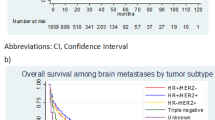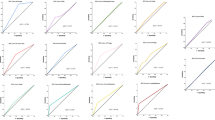Abstract
Brain metastases (BM) are one of the most common types of brain tumors and are a relatively common event in the disease process for several high-incidence cancer types, including breast and lung cancers. Historically, information on metastases including BM have not been collected as part of national cancer registration in the US, but BM at time of primary cancer diagnosis (SBM), is now collected by the National Cancer Institute’s (NCI) Surveillance, Epidemiology, and End Results (SEER) system. Using data from 18 SEER registries from 2010 to 2013, we assessed the frequency of SBM at time of primary diagnosis in the US by site, histology group, sex, race, age, and insurance status. There were 1,634,954 total primary cancer cases in SEER from 2010 to 2013, 1.7% of which presented with SBM. The cancer type with the highest proportion of SBM was lung cancer (10.8% of cases with SBM), followed by esophageal (1.5%), kidney (1.4%), and melanoma (1.2%). SBM varied by age, sex, race, and insurance status for most histologies. Our results reflect the high proportion of patients who are diagnosed with lung cancer at late stages and present with SBM, in contrast to other common cancers in the US where SBM is less common. Demographic variation in molecular subtype and risk behavior may influence variation in SBM. BM is a relatively common event in late stage cancer and cause significant morbidity and mortality, and assessment of accurate population-based data is critical to estimate total disease burden.




Similar content being viewed by others
References
Davis FG, Dolecek TA, McCarthy BJ, Villano JL (2012) Toward determining the lifetime occurrence of metastatic brain tumors estimated from 2007 United States cancer incidence data. Neuro Oncol 14:1171–1177. doi:10.1093/neuonc/nos152
Nathoo N, Chahlavi A, Barnett GH, Toms SA (2005) Pathobiology of brain metastases. J Clin Pathol 58:237–242. doi:10.1136/jcp.2003.013623
Villano JL, Durbin EB, Normandeau C, Thakkar JP, Moirangthem V, Davis FG (2015) Incidence of brain metastasis at initial presentation of lung cancer. Neuro Oncol 17:122–128. doi:10.1093/neuonc/nou099
Gavrilovic IT, Posner JB (2005) Brain metastases: epidemiology and pathophysiology. J Neurooncol 75:5–14. doi:10.1007/s11060-004-8093-6
Fox BD, Cheung VJ, Patel AJ, Suki D, Rao G (2011) Epidemiology of metastatic brain tumors. Neurosurg Clin N Am 22(1–6):v. doi:10.1016/j.nec.2010.08.007
Nayak L, Lee EQ, Wen PY (2012) Epidemiology of brain metastases. Curr Oncol Rep 14:48–54. doi:10.1007/s11912-011-0203-y
Feng W, Zhang P, Zheng X, Chen M, Mao WM (2015) Incidence and treatment of brain metastasis in patients with esophageal carcinoma. World J Gastroenterol 21:5805–5812. doi:10.3748/wjg.v21.i19.5805
Kaal EC, Niel CG, Vecht CJ (2005) Therapeutic management of brain metastasis. Lancet Neurol 4:289–298. doi:10.1016/S1474-4422(05)70072-7
Walker AE, Robins M, Weinfeld FD (1985) Epidemiology of brain tumors: the national survey of intracranial neoplasms. Neurology 35:219–226
Counsell CE, Collie DA, Grant R (1996) Incidence of intracranial tumours in the Lothian region of Scotland, 1989–90. J Neurol Neurosurg Psychiatry 61:143–150
Schouten LJ, Rutten J, Huveneers HA, Twijnstra A (2002) Incidence of brain metastases in a cohort of patients with carcinoma of the breast, colon, kidney, and lung and melanoma. Cancer 94:2698–2705
Barnholtz-Sloan JS, Sloan AE, Davis FG, Vigneau FD, Lai P, Sawaya RE (2004) Incidence proportions of brain metastases in patients diagnosed (1973–2001) in the Metropolitan Detroit Cancer Surveillance System. J Clin Oncol 22:2865–2872. doi:10.1200/JCO.2004.12.149
Wisniewski JR, Zougman A, Nagaraj N, Mann M (2009) Universal sample preparation method for proteome analysis. Nat Methods 6:359–362. doi:10.1038/nmeth.1322
Goncalves PH, Peterson SL, Vigneau FD, Shore RD, Quarshie WO, Islam K, Schwartz AG, Wozniak AJ, Gadgeel SM (2016) Risk of brain metastases in patients with nonmetastatic lung cancer: analysis of the Metropolitan Detroit Surveillance, Epidemiology, and End Results (SEER) data. Cancer 122:1921–1927. doi:10.1002/cncr.30000
Rostami R, Mittal S, Rostami P, Tavassoli F, Jabbari B (2016) Brain metastasis in breast cancer: a comprehensive literature review. J Neurooncol 127:407–414. doi:10.1007/s11060-016-2075-3
Surveillance Epidemiology and End Results (SEER) Program (2015) Number of persons by race and hispanic ethnicity for SEER participants (2010 census data)
International Agency for Research on Cancer (2000) International classification of diseases for oncology, 3rd edition (ICD-O-3)
Surveillance Epidemiology and End Results (SEER) Program (2008) Site recode ICD-O-3/WHO definition. http://seer.cancer.gov/siterecode/icdo3_dwhoheme/index.html
Surveillance Epidemiology and End Results (SEER) Program (2016) SEER*Stat software version 8.3.2. National Cancer Institute, DCCPS, Surveillance Research Program. http://www.seer.cancer.gov/seerstat
R Core Team (2016) R: a language and environment for statistical computing. R Foundation for Statistical Computing. http://www.R-project.org/
Wickham H (2009) ggplot2: elegant graphics for data analysis. Springer, New York. http://had.co.nz/ggplot2/book
Ward E, Jemal A, Cokkinides V, Singh GK, Cardinez C, Ghafoor A, Thun M (2004) Cancer disparities by race/ethnicity and socioeconomic status. CA Cancer J Clin 54:78–93
Halpern MT, Ward EM, Pavluck AL, Schrag NM, Bian J, Chen AY (2008) Association of insurance status and ethnicity with cancer stage at diagnosis for 12 cancer sites: a retrospective analysis. Lancet Oncol 9:222–231. doi:10.1016/S1470-2045(08)70032-9
Siegel RL, Miller KD, Jemal A (2016) Cancer statistics, 2016. CA Cancer J Clin 66:7–30. doi:10.3322/caac.21332
Bald T, Quast T, Landsberg J, Rogava M, Glodde N, Lopez-Ramos D, Kohlmeyer J, Riesenberg S, van den Boorn-Konijnenberg D, Homig-Holzel C, Reuten R, Schadow B, Weighardt H, Wenzel D, Helfrich I, Schadendorf D, Bloch W, Bianchi ME, Lugassy C, Barnhill RL, Koch M, Fleischmann BK, Forster I, Kastenmuller W, Kolanus W, Holzel M, Gaffal E, Tuting T (2014) Ultraviolet-radiation-induced inflammation promotes angiotropism and metastasis in melanoma. Nature 507:109–113. doi:10.1038/nature13111
Lazovich D, Isaksson Vogel R, Weinstock MA, Nelson HH, Ahmed RL, Berwick M (2016) Association between indoor tanning and melanoma in younger men and women. JAMA Dermatol 152: 268–275 doi:10.1001/jamadermatol.2015.2938
Lasithiotakis K, Leiter U, Meier F, Eigentler T, Metzler G, Moehrle M, Breuninger H, Garbe C (2008) Age and gender are significant independent predictors of survival in primary cutaneous melanoma. Cancer 112:1795–1804. doi:10.1002/cncr.23359
Amini A, Rusthoven CG, Waxweiler TV, Jones BL, Fisher CM, Karam SD, Raben D (2016) Association of health insurance with outcomes in adults ages 18 to 64 years with melanoma in the United States. J Am Acad Dermatol 74:309–316. doi:10.1016/j.jaad.2015.09.054
Won YW, Joo J, Yun T, Lee GK, Han JY, Kim HT, Lee JS, Kim MS, Lee JM, Lee HS, Zo JI, Kim S (2015) A nomogram to predict brain metastasis as the first relapse in curatively resected non-small cell lung cancer patients. Lung Cancer 88:201–207. doi:10.1016/j.lungcan.2015.02.006
Blackwell DL VM, Clarke TC (2015) Tables of summary health statistics for U.S. adults: 2013 National Health Interview Survey. http://www.cdc.gov/nchs/nhis/SHS/tables.htm
Schwartz AG, Cote ML (2016) Epidemiology of lung cancer. Adv Exp Med Biol 893:21–41. doi:10.1007/978-3-319-24223-1_2
Benowitz NL, Lessov-Schlaggar CN, Swan GE, Jacob P 3rd (2006) Female sex and oral contraceptive use accelerate nicotine metabolism. Clin Pharmacol Ther 79:480–488. doi:10.1016/j.clpt.2006.01.008
Gupta S, Hassan S, Bhatt VR, Abdul Sater H, Dilawari A (2014) Lung cancer trends: smoking, obesity, and sex assessed in the Staten Island University’s lung cancer patients. Int J Gen Med 7:333–337. doi:10.2147/IJGM.S55806
Haiman CA, Stram DO, Wilkens LR, Pike MC, Kolonel LN, Henderson BE, Le Marchand L (2006) Ethnic and racial differences in the smoking-related risk of lung cancer. N Engl J Med 354:333–342. doi:10.1056/NEJMoa033250
Wells A (2000) Tumor invasion: role of growth factor-induced cell motility. Adv Cancer Res 78:31–101
Shin DY, Lee DH, Kim CH, Koh JS, Lee JC, Baek HJ, Kim SW, Choi CM, Na, II (2016) Epidermal growth factor receptor mutations and brain metastasis in patients with nonadenocarcinoma of the lung. J Cancer Res Ther 12:318–322. doi:10.4103/0973-1482.154024
Han G, Bi J, Tan W, Wei X, Wang X, Ying X, Guo X, Zhou X, Hu D, Zhen W (2016) A retrospective analysis in patients with EGFR-mutant lung adenocarcinoma: is EGFR mutation associated with a higher incidence of brain metastasis? Oncotarget. doi:10.18632/oncotarget.10933
Sirkisoon SR, Carpenter RL, Rimkus T, Miller L, Metheny-Barlow L, Lo HW (2016) EGFR and HER2 signaling in breast cancer brain metastasis. Front Biosci (Elite Ed) 8:245–263
Shin DY, Na II, Kim CH, Park S, Baek H, Yang SH (2014) EGFR mutation and brain metastasis in pulmonary adenocarcinomas. J Thorac Oncol 9:195–199. doi:10.1097/jto.0000000000000069
Maxwell R, Garzon-Muvdi T, Lipson EJ, Sharfman WH, Bettegowda C, Redmond KJ, Kleinberg LR, Ye X, Lim M (2016) BRAF-V600 mutational status affects recurrence patterns of melanoma brain metastasis. Int J Cancer. doi:10.1002/ijc.30241
Nussbaum ES, Djalilian HR, Cho KH, Hall WA (1996) Brain metastases. Histology, multiplicity, surgery, and survival. Cancer 78:1781–1788
Funding
Funding for CBTRUS was provided by the Centers for Disease Control and Prevention (CDC) under Contract No. 200-2016-M-90304, The Sontag Foundation, Genentech, Novocure, Celldex, AbbVie, along with the Musella Foundation, Voices Against Cancer, and the Zelda Dorin Tetenbaum Memorial Fund, as well as private and in kind donations. Contents are solely the responsibility of the authors and do not necessarily represent the official views of the CDC.
Author information
Authors and Affiliations
Corresponding author
Ethics declarations
Conflict of interest
The authors declare that they have no conflict of interest.
Ethical approval
All procedures performed in studies involving human participants were in accordance with the ethical standards of the institutional and/or national research committee and with the 1964 Helsinki declaration and its later amendments or comparable ethical standards. This study was approved by the Institutional Review Board at University Hospitals Case Medical Center. For this type of study, formal consent was not required.
Informed consent
This was a retrospective study using de-identified national cancer registries. Thus, formal consent was not required.
Electronic supplementary material
Below is the link to the electronic supplementary material.
11060_2017_2516_MOESM2_ESM.png
Supplementary Figure 1. Type of Evaluation of any metastases by AJCC criteria for patients with SBM by A) site, B) lung cancer, and C) breast cancer subtype (Online Only) (PNG 40 KB)
Rights and permissions
About this article
Cite this article
Kromer, C., Xu, J., Ostrom, Q.T. et al. Estimating the annual frequency of synchronous brain metastasis in the United States 2010–2013: a population-based study. J Neurooncol 134, 55–64 (2017). https://doi.org/10.1007/s11060-017-2516-7
Received:
Accepted:
Published:
Issue Date:
DOI: https://doi.org/10.1007/s11060-017-2516-7




